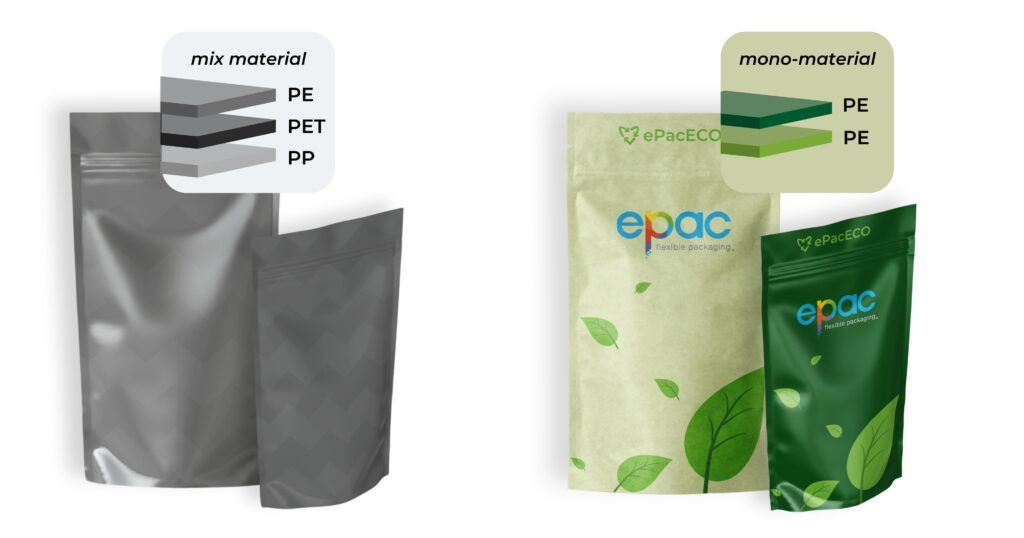The Packaging and Packaging Waste Regulation (PPWR) significantly reduces the environmental impact of packaging waste across the European Union. This regulation seeks to address the growing concern over packaging waste and its detrimental effects on the environment by implementing stringent requirements and promoting sustainable practices in packaging. In this blog post, we’ll delve into what the PPWR future requirements, the different grading levels it introduces, and its impact on the flexible packaging industry.
What is PPWR?
The Packaging and Packaging Waste Regulation (PPWR) comprehensively minimizes packaging waste and promotes the use of sustainable materials in packaging. The primary objectives of the PPWR include:

- Reducing Packaging Waste:
By setting targets for the reduction of packaging waste, the PPWR aims to lessen the environmental burden caused by discarded packaging materials. - Encouraging Recyclability:
The regulation promotes the use of recyclable materials and designs that facilitate easier recycling processes. - Minimising Hazardous Substances:
The PPWR seeks to limit the use of hazardous substances in packaging to protect human health and the environment. - Promoting Reuse:
Encouraging the development of reusable packaging solutions to extend the lifecycle of packaging materials.
Future Requirements Under PPWR
The PPWR outlines several future requirements that manufacturers and businesses involved in packaging must adhere to:
- Increased Recycling Targets: Higher recycling targets for packaging materials will be set, pushing companies to design packaging that is easier to recycle.
- Use of Recycled Content: Packaging will be required to incorporate a certain percentage of recycled content, promoting the circular economy.
- Reduction of Over-Packaging: Measures to prevent over-packaging will be enforced, encouraging companies to use only the necessary amount of packaging material.
- Eco-Design Standards: Packaging will need to meet specific eco-design criteria, focusing on recyclability, reusability, and the reduction of harmful substances.
Grading Levels in PPWR
The PPWR introduces different grading levels to categorise packaging based on its environmental impact and compliance with the regulation’s standards. These grading levels include:
- Grade A: Packaging that is fully recyclable, made from mono-materials, and contains a high percentage of recycled content.
- Grade B: Packaging that is recyclable but may contain a mix of materials, making the recycling process more complex.
- Grade C: Packaging that is partially recyclable but contains non-recyclable components.
- Grade D: Packaging that is not recyclable and does not meet the PPWR’s eco-design standards.
PPWR & Flexible Packaging
The PPWR is set to have a significant impact on the flexible packaging industry. However, ePac is already working to the standards set, with our focus on mono-material structions. Flexible packaging, known for its versatility and lightweight properties, stands to benefit from the regulation’s emphasis on sustainability. Here’s how:
- Preference for Mono-Material Packaging: The PPWR prefers mono-material packaging over compostable or biodegradable options because mono-materials are easier to recycle. This aligns well with the flexible packaging industry, which can adapt to using single-material designs that meet recycling standards.
- Encouraging Lightweight Packaging: The regulation promotes the use of lightweight packaging, which is a key characteristic of flexible packaging. Lightweight packaging reduces material usage and transportation emissions, making it an eco-friendly choice.
- Reducing Packaging Waste: By encouraging the reduction of packaging waste, the PPWR supports innovations in flexible packaging that minimize material usage without compromising functionality. This leads to more efficient packaging solutions that align with environmental goals.
- Eco-Design and Recyclability: Flexible packaging can be designed to meet the eco-design criteria set by the PPWR, focusing on recyclability and the use of recycled content. This can enhance the marketability of flexible packaging products as sustainable options.

The PPWR represents a significant step forward in the quest for sustainable packaging solutions. The regulation sets higher standards for recyclability, promotes the use of recycled content, and encourages the reduction of packaging waste, paving the way for a more sustainable future. The flexible packaging industry leverages its inherent advantages of lightweight and adaptable designs to thrive under the PPWR’s framework.By embracing mono-material solutions and eco-friendly practices, flexible packaging can lead the charge towards a greener, more sustainable packaging landscape.
If you would like to speak to our packaging experts regarding PPWR, please click here.
